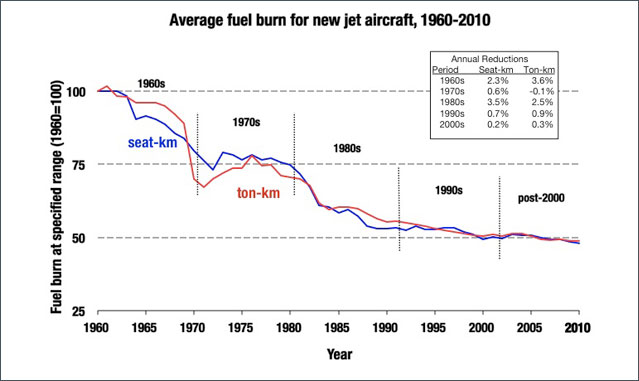Blog
Overturning conventional wisdom on aircraft efficiency trends
Conventional wisdom has it that commercial aviation produces continuous improvements in efficiency by quickly adopting fuel-efficient technologies and designs as a natural response to fuel prices. As this graph indicates, the truth is more complicated.
 Activity- and sales-weighted fuel efficiency trends for new jet aircraft from 1960 to 2010 suggest that fuel prices alone have not produced consistent improvements in aircraft efficiency, and that improvements in fuel efficiency due to the introduction of new aircraft have decreased over time. Although the average fuel efficiency of new passenger aircraft has approximately doubled on both a seat-km (passengers only) and ton-km (passengers + freight) basis since 1960, new aircraft efficiency has improved substantially in only two of the last five decades, and stagnated in recent years. On average, since 2000 fuel burn has fallen only 0.2% and 0.3% annually on a seat-km and ton-km basis, respectively. Diminished efficiency gains are correlated with historically low fuel prices between 1987 and 2004 and a tripling in the average age of aircraft and engine manufacturer production lines since 1989.
Activity- and sales-weighted fuel efficiency trends for new jet aircraft from 1960 to 2010 suggest that fuel prices alone have not produced consistent improvements in aircraft efficiency, and that improvements in fuel efficiency due to the introduction of new aircraft have decreased over time. Although the average fuel efficiency of new passenger aircraft has approximately doubled on both a seat-km (passengers only) and ton-km (passengers + freight) basis since 1960, new aircraft efficiency has improved substantially in only two of the last five decades, and stagnated in recent years. On average, since 2000 fuel burn has fallen only 0.2% and 0.3% annually on a seat-km and ton-km basis, respectively. Diminished efficiency gains are correlated with historically low fuel prices between 1987 and 2004 and a tripling in the average age of aircraft and engine manufacturer production lines since 1989.
These findings suggest that an aircraft CO2 standard, which is currently under development by the UN’s International Civil Aviation Organization (ICAO), is most likely to reduce emissions if it applies to all newly built aircraft from current production lines, not just to new designs.
